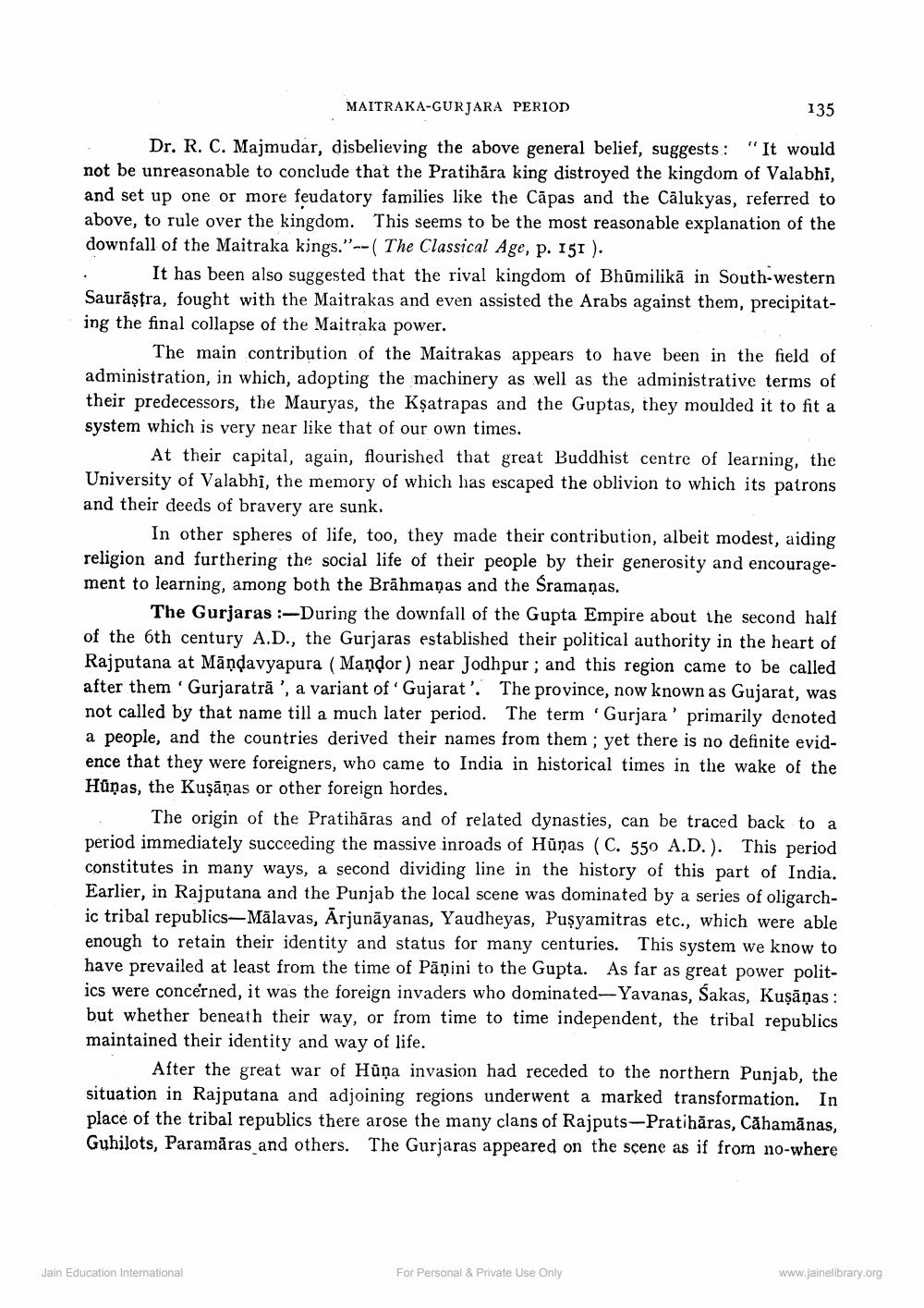________________
MAITRAKA-GURJARA PERIOD
135
Dr. R. C. Majmudar, disbelieving the above general belief, suggests: "It would not be unreasonable to conclude that the Pratihāra king distroyed the kingdom of Valabhi, and set up one or more feudatory families like the Cāpas and the Calukyas, referred to above, to rule over the kingdom. This seems to be the most reasonable explanation of the downfall of the Maitraka kings."-- The Classical Age, p. 151 ). . It has been also suggested that the rival kingdom of Bhūmilikā in South-western Saurāṣtra, fought with the Maitrakas and even assisted the Arabs against them, precipitating the final collapse of the Maitraka power.
The main contribution of the Maitrakas appears to have been in the field of administration, in which, adopting the machinery as well as the administrative terms of their predecessors, the Mauryas, the Ksatrapas and the Guptas, they moulded it to fit a system which is very near like that of our own times.
At their capital, again, flourished that great Buddhist centre of learning, the University of Valabhi, the memory of which has escaped the oblivion to which its patrons and their deeds of bravery are sunk.
In other spheres of life, too, they made their contribution, albeit modest, aiding religion and furthering the social life of their people by their generosity and encouragement to learning, among both the Brāhmaṇas and the Sramaņas.
The Gurjaras :-During the downfall of the Gupta Empire about the second half of the 6th century A.D., the Gurjaras established their political authority in the heart of Rajputana at Māņdavyapura ( Mandor) near Jodhpur ; and this region came to be called after them 'Gurjaratrā ', a variant of Gujarat'. The province, now known as Gujarat, was not called by that name till a much later period. The term 'Gurjara' primarily denoted a people, and the countries derived their names from them; yet there is no definite evidence that they were foreigners, who came to India in historical times in the wake of the Hüņas, the Kuşāņas or other foreign hordes.
The origin of the Pratihāras and of related dynasties, can be traced back to a period immediately succeeding the massive inroads of Hūņas (C. 550 A.D.). This period constitutes in many ways, a second dividing line in the history of this part of India. Earlier, in Rajputana and the Punjab the local scene was dominated by a series of oligarchic tribal republics— Mālavas, Arjunāyanas, Yaudheyas, Pușyamitras etc., which were able enough to retain their identity and status for many centuries. This system we know to have prevailed at least from the time of Pāṇini to the Gupta. As far as great power politics were concerned, it was the foreign invaders who dominated-Yavanas, Sakas, Kuşāņas : but whether beneath their way, or from time to time independent, the tribal republics maintained their identity and way of life.
After the great war of Hüņa invasion had receded to the northern Punjab, the situation in Rajputana and adjoining regions underwent a marked transformation. In place of the tribal republics there arose the many clans of Rajputs-Pratihāras, Cāhamānas, Guhilots, Paramāras and others. The Gurjaras appeared on the scene as if from no-where
Jain Education International
For Personal & Private Use Only
www.jainelibrary.org




